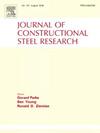A novel restoring force model for metallic dampers incorporating performance degradation
IF 4
2区 工程技术
Q1 CONSTRUCTION & BUILDING TECHNOLOGY
引用次数: 0
Abstract
The metallic dampers have been widely used in energy dissipation systems. To more accurately describe their nonlinear mechanical behaviour, this paper develops a novel restoring force model incorporating performance degradation and complied into a UMAT subroutine with ABAQUS as platform. The force-deformation relationship of the proposed model is divided into two stages: small and large deformation stages. In the small deformation stage, the combined hardening model in the form of exponential functions is utilized to predict the restoring force of the dampers. Kinematic and isotropic hardening variables are introduced to reflect the Bauschinger effect and cyclic hardening of the metallic dampers, respectively. When the accumulative plastic deformation surpasses a specific value, the restoring force model transitions to the large deformation stage. In this stage, exponential function and sigmoid function are applied to modify the combined hardening model, reflecting stiffness and strength degradation caused by significant out-of-plane deformation and fracture of metallic dampers, respectively. To validate the accuracy and enhancement of the proposed model, experimental results from ten metallic dampers reported in the literature are compared with the simulation results of the proposed model and other three widely-used models. Three indices, in terms of the peak force , the residual force at the final loading cycle , and cumulative dissipated energy , are employed to quantitatively evaluate the accuracy of the restoring force model. The results indicate that the proposed model accurately captures the mechanical behaviour of metallic dampers, with relative differences in these indices below 10 %. In contrast, differences between experimental results and the three other models typically exceed 10 %. Notably, since performance degradation is not accounted for in these three models, they overestimate the peak and residual forces of metallic dampers, with maximum errors reaching 30 % and 150 %, respectively. Additionally, the effectiveness of the proposed model under real-world conditions is verified by comparing results from Y-eccentrically braced composite frame specimens subjected to lateral cyclic loading and shake table testing. Finally, the limitations of the proposed model are also discussed.
考虑性能退化的新型金属阻尼器恢复力模型
金属阻尼器在耗能系统中得到了广泛的应用。为了更准确地描述其非线性力学行为,本文建立了一种考虑性能退化的新型恢复力模型,并以ABAQUS为平台编写了UMAT子程序。该模型的力-变形关系分为小变形阶段和大变形阶段。在小变形阶段,采用指数函数形式的组合硬化模型预测阻尼器的恢复力。引入运动硬化变量和各向同性硬化变量分别反映金属阻尼器的包辛格效应和循环硬化。当累计塑性变形超过一定值时,恢复力模型进入大变形阶段。本阶段采用指数函数和s型函数对组合硬化模型进行修正,分别反映金属阻尼器显著的面外变形和断裂导致的刚度退化和强度退化。为了验证所提模型的准确性和增强性,将文献中报道的10种金属阻尼器的实验结果与所提模型和其他三种广泛使用的模型的仿真结果进行了比较。采用峰值力Fp、最终加载周期剩余力Fr和累积耗散能Ea三个指标定量评价恢复力模型的准确性。结果表明,所提出的模型准确地捕捉了金属阻尼器的力学行为,这些指标的相对差异在10%以下。相比之下,实验结果与其他三种模型之间的差异通常超过10%。值得注意的是,由于在这三个模型中没有考虑性能退化,它们高估了金属阻尼器的峰值和残余力,最大误差分别达到30%和150%。此外,通过比较横向循环加载和振动台试验的y型偏心支撑复合框架试件的结果,验证了该模型在实际条件下的有效性。最后,本文还讨论了该模型的局限性。
本文章由计算机程序翻译,如有差异,请以英文原文为准。
求助全文
约1分钟内获得全文
求助全文
来源期刊

Journal of Constructional Steel Research
工程技术-工程:土木
CiteScore
7.90
自引率
19.50%
发文量
550
审稿时长
46 days
期刊介绍:
The Journal of Constructional Steel Research provides an international forum for the presentation and discussion of the latest developments in structural steel research and their applications. It is aimed not only at researchers but also at those likely to be most affected by research results, i.e. designers and fabricators. Original papers of a high standard dealing with all aspects of steel research including theoretical and experimental research on elements, assemblages, connection and material properties are considered for publication.
 求助内容:
求助内容: 应助结果提醒方式:
应助结果提醒方式:


